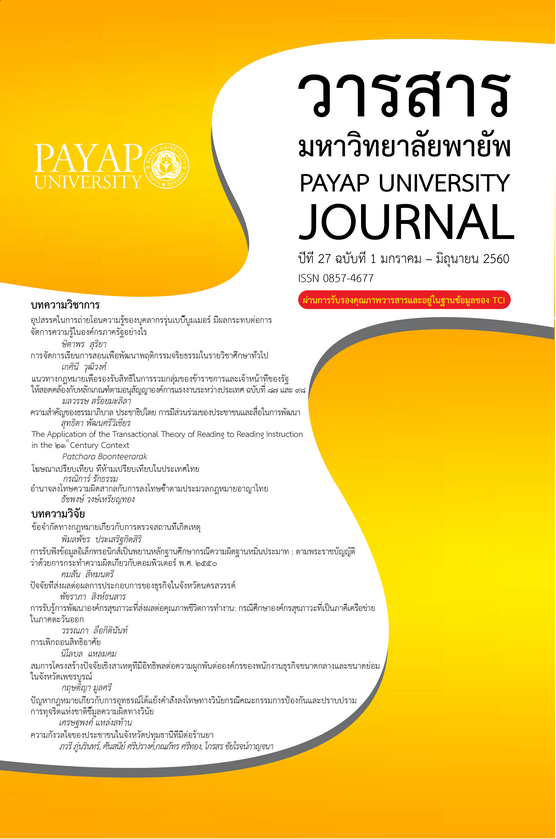สมการโครงสร้างปัจจัยเชิงสาเหตุที่มีอิทธิพลต่อความผูกพันต่อองค์กรของพนักงานธุรกิจขนาดกลางและขนาดย่อมในจังหวัดเพชรบูรณ์
Main Article Content
บทคัดย่อ
งานวิจัยนี้มีวัตถุประสงค์เพื่อศึกษารูปแบบสมการโครงสร้างปัจจัยเชิสาเหตุที่มีอิทธิพลต่อความผูกพันต่อองค์กรของพนักงานธุรกิจขนาดกลางและขนาดย่อม กลุ่มตัวอย่างที่ใช้ในการศึกษาครั้งนี้ คือ พนักงานธุรกิจขนาดกลางและขนาดย่อมในเขตจังหวัดเพชรบูรณ์ จำนวน 550 คน เครื่องมือที่ใช้ในการเก็บรวบรวมข้อมูล คือ แบบสอบถามในรูปแบบมาตราส่วนประมาณค่า 5 ระดับ สถิติที่ใช้ในการวิเคราะห์ ได้แก่ ร้อยละและการวิเคราะห์โมเดลสมการโครงสร้าง ผลการวิจัยพบว่า รูปแบบอิทธิพลเชิงสาเหตุของปัจจัยที่มีผลต่อความผูกพันต่อองค์กรของพนักงานธุรกิจขนาดกลางและขนาดย่อม ที่ได้รับการพัฒนาขึ้นมีความสอดคล้องกับข้อมูลเชิงประจักษ์ เนื่องจากมีความกลมกลืนของโมเดลกับข้อมูลเชิงประจักษ์ และมีประสิทธิภาพ ความสามารถในการพยากรณ์อยู่ในระดับดีและเป็นที่ยอมรับ โดยมีค่าสหสัมพันธ์พหุคูณกำลังสอง (R2) คิดเป็นร้อยละ 61.7 ซึ่งผ่านเกณฑ์พิจารณาที่มีค่าร้อยละ 40 ขึ้นไป และมีอิทธิพลเส้นทางของโมเดลคือ ความสัมพันธ์กับผู้อื่น ซึ่งได้แก่ ความสัมพันธ์กับผู้บังคับบัญชา เพื่อนร่วมงานและกลุ่มทีมงาน มีอิทธิพลทางตรงไปยังความพึงพอใจในการทำงานเป็นอันดับที่ 1 (DE=0.978) สภาพการทำงาน ซึ่งได้แก่ สถานที่ทำงาน ห้องทำงาน เครื่องมือ อุปกรณ์ มีความปลอดภัย เหมาะสมกันงานที่ปฏิบัติ และมีกฎระเบียบการบริหารจัดการที่ชัดเจน มีอิทธิพลทางตรงไปยังความพึงพอใจในการทำงานเป็นอันดับที่ 2 (DE=0.548) ผลประโยชน์ตอบแทน ได้แก่ ค่าตอบแทน สวัสดิการ และความก้าวหน้า มีอิทธิพลทางตรงไปยังความพึงพอใจในการทำงานเป็นอันดับ ที่ 3 (DE=0.521) และปัจจัยด้านความพึงพอใจในการทำงาน มีอิทธิพลทางตรงไปยังความผูกพันต่อองค์กร (DE=0.785)
Article Details
เอกสารอ้างอิง
กัลยา วานิชย์บัญชา. (2556). การวิเคราะห์สมการโครงสร้าง (SEM) ด้วย AMOS. กรุงเทพฯ: สามลดา.
ชูชัย สมิทธิไกร (2554). จิตวิทยาอุตสาหกรรมและองค์การ. พิมพ์ครั้งที่ 1. กรุงเทพฯ: จุฬาลงกรณ์มหาวิทยาลัย
ดนตรีทวี ไทรวิจิตร มนตรี พิริยะกุลและประยงค์ มีใจซื่อ (2555). อิทธิพลของปัจจัยเชิงสาเหตุที่ส่งผลต่อผลการปฏิบัติงานของพนักงาน บริษัท ทีโอที จำกัด (มหาซน). วารสารการจัดการ คณะวิทยาการจัดการ มหาวิทยาลัยราชภัฏลำปาง. 5(2): 93-102).
นงลักษณ์ วิรัชชัย.(2542). โมเดลลิสเรล : สถิติวิเคราะห์สำหรับการวิจัย. พิมพ์ครั้งที่ 3. กรุงเทพฯ:จุฬาลงกรณ์มหาวิทยาลัย.
วิชัย แหวนเพชร. (2548). มนุษยสัมพันธ์ในการบริหารอุตสาหกรรม. พิมพ์ครั้งที่ 3. กรุงเทพๆ: ธรรมกมล
สำนักงานส่งเสริมวิสาหกิจขนาดกลางและขนาดย่อม. (2557). รายงานสถานการณ์สรกิจขนาดกลาง และขนาด ย่อม.[ออน-ไลน์].แหล่งทีมา: https://www.sme.go.th/th/images/data/SR/download/07 July/ บทที่%204%20จำนวนและการจ้างงาน%20SME%20ปี%202556.pdf [2557, มิถุนายน 8]
Allen, N.J. and Meyer, J.p. and Smith, C.A. 1993. Commitment to organizations and occupations: Extension and test of a three component conceptualization. Journal of Applied Psychology. 78 (4): 538-551.
Allen, N.J., and Meyer, J.p. (et al). (1990). The Measurement and Antecedents of Affective, Continuance, and Normative Commitment to the Organization. Journal of Occupational Psychology. 63: 1-8.
Buchanan, (1974). Building organizational commitment: The socialization of managers in work organizations [Electronic version]. Administrative Science Quarterly, 19(4): 533-546.
David, S. (2015). Impacts of Job Satisfaction and Organizational commitment: A study Describing Influence of Gender Difference on Job Satisfaction and Organizational Commitment. International Journal Of Cor Engineering & Management (IJCEM), 2(1): 93-111
Etzel, M. J., Walker, B. J., & Stanton, W. J. (2007). Marketing (14th ed.). New York: McGraw-Hill.
Griffeth, R. W., Horn, p. W. & Gaertner, ร. (2000). A meta-analysis of antecedents and correlates of employee turnover: Update, moderator tests, and research implications for the next millennium. Journal of Management, 26: 463-88.
Hair, J. F., Black, W. c., Babin, B. J. & Anderson, R. E. (2010). Multivariate data analysis: A global perspective. 7th ed. Upper Saddle River: Pearson Education.
Kanter, R.M. (1968). Commitment and social organization: A study of commitment mechanisms in utopian communities [Electronic version]. American Sociological Review, 33(4): 499¬517.
Krejcie, R. V. & Morgan, D. W. (1970). Determining Sample Size for Research Activities. Educational and Psychological Measurement, 30(3): 607-610.
Mohammed, F. & Eleswed, M. (2013). Job Satisfaction and Organization Commitment: A Correlational study in Bahrain. International Journal of Business, Humanities and Technology. 3(5): 43-53.
Nguyen, T.N., Mai, K.N. & Nguyen, p.v. (2014). Factors Affecting Employees’ Organizational Commitment-A study of Banking staff in Ho Chi Minh City, Vietnam. Journal of Advanced Management Science. 2(1): 7-11.
Steers, R.M. (1977). Antecedents and outcomes of organizational commitment. Administrative Science Quarterly, 22: 46-56.
Vidal, S. E., Valle, S. R. & Aragon, B. I. (2007). Antecedents of repatriates’ job satisfaction and its influence on turnover intentions: Evidence from Spanish repatriated managers. Journal of Business Research, 60: 1272-1281.
Yamane, Taro. (1973). Statistics: An Introductory Analysis. Third edition. Newyork: Harper and Row Publication.


